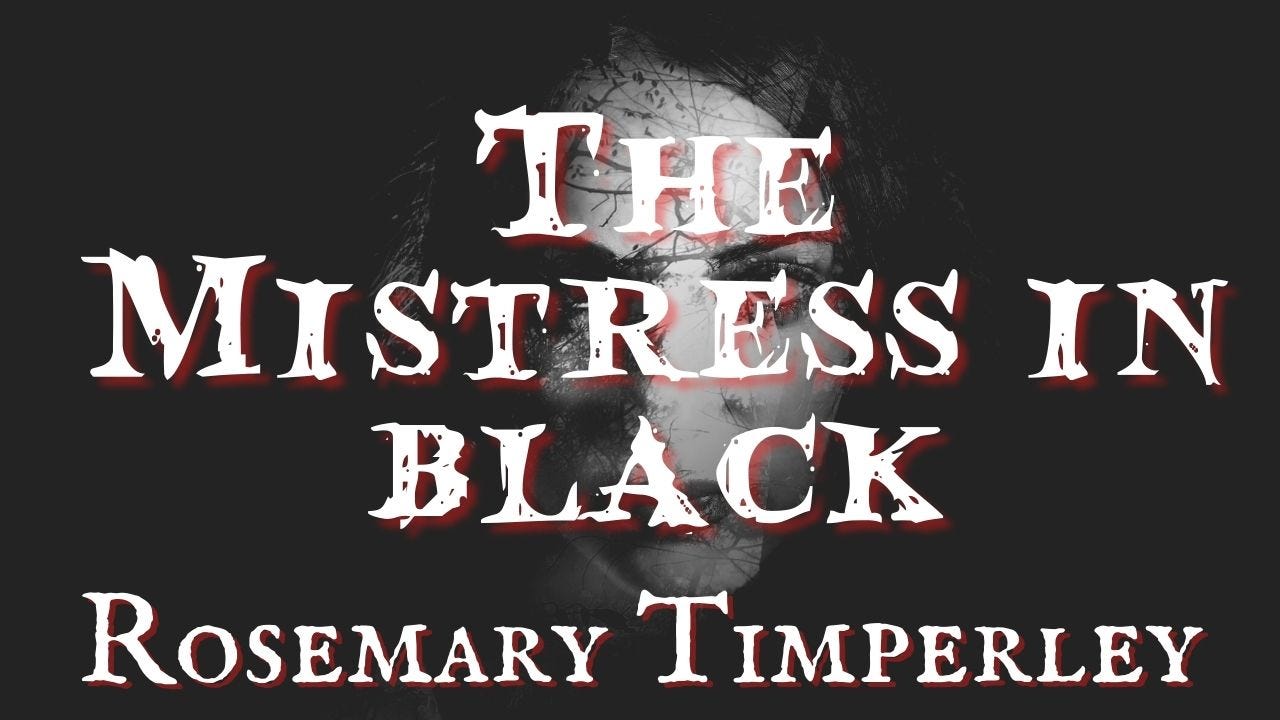
Rosemary Timperley was born in 1920 in North London and died in November 1988. Her father was an architect and her mother a teacher. Timperley went to her local girls’ school and became a teacher herself.
She taught English and history at a state school. Her pupils said she was a very dramatic figure (she ran the drama club) and wore long, swirling black dresses with long drop or hoop earrings.
Classic Ghost Stories Podcast is a reader-supported publication. To receive new posts and support my work, consider becoming a free or paid subscriber.
In 33 years, she published 66 novels and several hundred short stories. However, her ghost stories are the ones that people remember the most. She also put together a number of collections of ghost stories
She was editor of various editions of the Pan Ghost Book, including the 5th. This story, The Mistress In Black, was taken from that book, published in 1969.
Many of her short stories were published in magazines such as The New Yorker, Harper's Bazaar, and The Atlantic Monthly. Timperley's work often dealt with supernatural and paranormal themes, and she was considered a master of the ghost story genre. She also wrote several non-fiction books and articles on subjects such as writing and the supernatural. Timperley passed away in 1988.
While she was a teacher, she began to submit her stories to magazines, and they began to be accepted. She became a staff writer and agony aunt on the magazine Reveille. She lived in Richmond, Surrey (a well-heeled suburb of London now) for many years. Many of her stories are set in London.
During the Second World War, she worked at the Citizens’ Advice Bureau in Kensington, London. She got married to a physics teacher in 1952, and they lived in Essex, just outside London. They separated in the early 1960s, according to some sources, but they appear to have been officially married until his death in 1968.
Timperley managed to travel widely across the world despite her hectic writing schedule, visiting Italy (a number of her works are set in Venice), Morocco, Belgium, Russia, and Greece.
Robert Hale, who was Timperley's publisher, said that her novels, plays, and short stories were influenced by her real-life experiences in other countries and her wide range of jobs. Indeed, Timperley is believed to have worked as a waitress, a counter assistant in a police canteen, a typewriter operator, and an artist's model before becoming a freelance writer. Timperley had to spend several months in the hospital in 1964 because of a serious illness.
After this life-changing event, Timperley went to work as an assistant nurse in a Surrey hospital. Her time in this industry surely influenced works such as The Tragedy Business (1969), The Haunted Garden (1966), and The Washers-Up (1967). She was also inspired by her experience as a teacher, as is evident by the fact that children play a significant role in most of her work. Also, the settings of her first two books are thought to have been based on her childhood at Hornsey High School.
Timperley spent much of her life in the London suburb of Richmond, and many of her stories are set there. Timperley knew a lot about London, and her books, especially, have a lot of references to different places in the city. Reading her anecdotes, it's clear that Timperley travelled by tube and bus a lot, avoiding the use of a car and, despite being city born and bred, loved open landscapes and desired to live an uncluttered, "carefree" existence.
In 1961, she mentions she is living in an old-fashioned flat and living on coffee, pink gin, and cigarettes. In 1964, she became seriously ill and had a long spell in the hospital. I’m not surprised, hearing about her diet.
She led a quiet, reclusive life until her death in 1988, which, despite her previous success, went unnoticed by the press, and no obituary was published.
This is a public episode. If you’d like to discuss this with other subscribers or get access to bonus episodes, visit tonywalker.substack.com/subscribe
More Episodes
 2020-11-17
2020-11-17
 2020-11-15
2020-11-15
 2020-11-13
2020-11-13
 2020-11-11
2020-11-11
 2020-11-09
2020-11-09
 2020-11-07
2020-11-07
 2020-11-07
2020-11-07
 2020-10-31
2020-10-31
 2020-10-15
2020-10-15
 2020-10-08
2020-10-08
 2020-10-05
2020-10-05
 2020-09-27
2020-09-27
 2020-09-25
2020-09-25
 2020-09-22
2020-09-22
 2020-09-22
2020-09-22
 2020-09-20
2020-09-20
 2020-09-20
2020-09-20
Create your
podcast in
minutes
- Full-featured podcast site
- Unlimited storage and bandwidth
- Comprehensive podcast stats
- Distribute to Apple Podcasts, Spotify, and more
- Make money with your podcast
It is Free
- Privacy Policy
- Cookie Policy
- Terms of Use
- Consent Preferences
- Copyright © 2015-2024 Podbean.com






